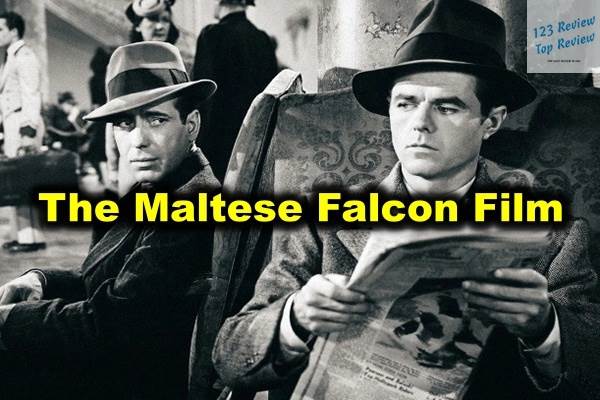Adapted from Dashiell Hammett’s 1930 novel of the same name, the Maltese Falcon film is often cited as a cornerstone of the film noir genre. Huston’s directorial debut was not only a critical and commercial success, but it also solidified the careers of several key players, including Humphrey Bogart, who delivered one of his most iconic performances as the hard-boiled private detective Sam Spade.
In this article, 123 Review will explore the film’s thematic depth, character development, cinematic techniques, narrative structure, performances, significance within the genre, reception, awards, and enduring cultural legacy.
Film Analysis
Themes Explored
The Maltese Falcon is a film rich in thematic content, delving into the dark underbelly of human nature and exploring the moral ambiguities that define the noir genre. At its core, the film is a meditation on greed and the corrupting influence of wealth. The quest for the titular Maltese Falcon, a priceless artifact rumored to be encrusted with jewels, drives the plot and motivates the actions of nearly every character. This pursuit of wealth at any cost leads to betrayal, manipulation, and murder, revealing the depths to which individuals will sink in their quest for material gain.

Another central theme is the ambiguity of morality. In the world of The Maltese Falcon, there are no clear heroes or villains; instead, the characters operate in shades of gray. Sam Spade, the protagonist, embodies this moral complexity. While he adheres to a personal code of ethics, his methods are often ruthless, and his motivations are not always pure. The femme fatale Brigid O’Shaughnessy further complicates the moral landscape, as her deceptive nature and shifting allegiances make it difficult to discern her true intentions. This exploration of moral ambiguity is a defining characteristic of film noir and contributes to the film’s enduring appeal.
Character Development
The characters in The Maltese Falcon are not merely archetypes; they are fully realized individuals with intricate backstories and motivations. Sam Spade, played with steely resolve by Humphrey Bogart, is a study in contrasts. On the surface, he is a tough, cynical detective who operates on the fringes of the law. However, beneath this hard exterior lies a man with a complex moral code. Spade’s actions are driven by a mix of self-interest and a desire for justice, making him a quintessential anti-hero of the noir genre.
Brigid O’Shaughnessy, portrayed by Mary Astor, is one of the most enigmatic characters in the film. As the femme fatale, she embodies the seductive and treacherous qualities that define the archetype. Brigid’s motivations are deliberately obscured, keeping both Spade and the audience guessing until the film’s climax. Her ability to manipulate those around her speaks to her cunning and resourcefulness, yet her vulnerability hints at deeper layers to her character.
The supporting characters, including Joel Cairo (Peter Lorre), Kasper Gutman (Sydney Greenstreet), and Wilmer Cook (Elisha Cook Jr.), each add depth and complexity to the narrative. Joel Cairo is a nervy, effeminate character whose polite demeanor masks a ruthless determination to acquire the Falcon. Kasper Gutman, known as “The Fat Man,” is a larger-than-life figure whose jovial exterior belies a cold, calculating nature. Wilmer Cook, Gutman’s young, hot-headed accomplice, is a dangerous but ultimately tragic figure, emblematic of the expendable nature of those who get caught up in the pursuit of wealth.
Cinematic Techniques
Directorial Choices
John Huston’s direction in The Maltese Falcon is marked by a confident, assured hand that belies the fact that it was his first film as a director. Huston’s decision to remain faithful to Dashiell Hammett’s novel, both in terms of dialogue and structure, was a bold move that paid off handsomely. The film’s screenplay, written by Huston himself, is notable for its sharp, rapid-fire dialogue that crackles with tension and wit. Huston’s screenplay is so closely aligned with Hammett’s novel that many lines of dialogue are lifted verbatim from the book, creating a film that feels both literary and cinematic.
One of Huston’s most significant contributions to the film was his use of a tightly controlled narrative structure, which keeps the audience constantly engaged. He meticulously plotted the film’s pacing, ensuring that each scene builds upon the last, with no wasted moments. This economy of storytelling is a hallmark of classic Hollywood cinema and is one of the reasons why The Maltese Falcon remains so compelling even decades after its release.
Cinematography Style
The visual style of The Maltese Falcon is a textbook example of film noir cinematography. Arthur Edeson, the film’s cinematographer, employed a range of techniques to create the moody, atmospheric visuals that define the film. The use of low-key lighting, with its deep shadows and stark contrasts, is particularly effective in creating a sense of unease and foreboding. This chiaroscuro effect, where the interplay of light and shadow dominates the visual composition, not only enhances the film’s mood but also serves as a visual metaphor for the moral ambiguities that lie at the heart of the story.
Edeson also made extensive use of unconventional camera angles, including low-angle shots that emphasize the power dynamics between characters, and tight close-ups that capture the nuances of the actors’ performances. The camera work in The Maltese Falcon is fluid and dynamic, with a sense of movement that mirrors the tension and unpredictability of the narrative. This cinematographic style would become a hallmark of film noir, influencing countless films in the years to come.
Narrative Structure
Plot Progression
The narrative structure of The Maltese Falcon is tightly woven, with each plot point carefully crafted to build suspense and maintain the audience’s interest. The film opens with the murder of Sam Spade’s partner, Miles Archer, which sets the plot in motion. From there, the story unfolds in a series of encounters between Spade and the various characters who are all, in one way or another, connected to the search for the Maltese Falcon.
As the plot progresses, Spade becomes entangled in a web of deceit, as he navigates the conflicting interests of Brigid O’Shaughnessy, Joel Cairo, and Kasper Gutman. The narrative is marked by a series of revelations and reversals, each one deepening the mystery and raising the stakes. The tension reaches its peak in the film’s climactic scenes, where the true nature of the Maltese Falcon is revealed, and the characters’ motivations are laid bare.
Key Events and Twists
Several key events drive the narrative forward and contribute to the film’s lasting impact. The initial murder of Miles Archer serves as the catalyst for the story, drawing Spade into a complex investigation that quickly spirals out of control. The introduction of Brigid O’Shaughnessy as a mysterious client further complicates matters, as her shifting allegiances and hidden motives keep both Spade and the audience on edge.
One of the film’s most memorable twists occurs when it is revealed that the Maltese Falcon, the object of everyone’s obsession, is actually a worthless replica. This revelation not only serves as a commentary on the futility of the characters’ greed-driven pursuits but also reinforces the film’s themes of deception and betrayal. The final twist, where Spade turns Brigid over to the police despite his apparent affection for her, underscores the film’s commitment to moral ambiguity, leaving the audience with a sense of unease and unresolved tension.
Performance Evaluation
Lead Actor Assessment
Humphrey Bogart’s portrayal of Sam Spade is widely regarded as one of the defining performances of his career. Bogart brings a nuanced complexity to the role, blending toughness and vulnerability in a way that makes Spade both relatable and enigmatic. His delivery of the film’s sharp, biting dialogue is pitch-perfect, capturing the cynicism and world-weariness that characterize the character. Bogart’s physicality in the role, from his relaxed posture to his quick, decisive movements, further enhances the sense of Spade as a man who is always in control, even when the odds are stacked against him.
Bogart’s performance in The Maltese Falcon was a turning point in his career. Prior to this film, he had often been cast in supporting roles or as the villain. However, his portrayal of Sam Spade established him as a leading man and solidified his image as the quintessential film noir hero. Bogart’s Spade is not just a detective; he is a fully realized character whose moral complexities and internal conflicts resonate with audiences, making him one of the most iconic figures in cinematic history.
Supporting Cast Impressions
The supporting cast of The Maltese Falcon is equally impressive, with each actor delivering a performance that complements and enhances the overall narrative. Mary Astor’s portrayal of Brigid O’Shaughnessy is a standout, as she navigates the character’s complex motivations with grace and subtlety. Astor’s ability to convey vulnerability and duplicity in equal measure makes Brigid one of the most compelling femme fatales in film history.
Peter Lorre’s performance as Joel Cairo is both memorable and unsettling. Lorre imbues Cairo with a nervous energy that contrasts sharply with the more composed characters, adding an additional layer of tension to the film. Sydney Greenstreet, in his film debut, delivers a masterful performance as Kasper Gutman. Greenstreet’s imposing physical presence and his ability to convey both charm and menace make Gutman a formidable antagonist. His character is one of the most memorable in the film, and Greenstreet’s performance earned him an Academy Award nomination for Best Supporting Actor.
Genre Significance
Contribution to Film Noir
The Maltese Falcon is often credited with helping to define the film noir genre, which would come to dominate American cinema in the 1940s and 1950s. While the genre existed in various forms before this film, The Maltese Falcon codified many of the elements that would become synonymous with film noir: morally ambiguous characters, a dark and cynical worldview, and a visual style characterized by stark contrasts and shadowy lighting.
The film’s influence on the genre can be seen in its portrayal of the detective figure, which became a staple of noir films. Sam Spade’s character set the template for the hard-boiled detective, a figure who is both a part of and apart from the criminal underworld he navigates. The film’s themes of greed, betrayal, and the corrupting influence of wealth also became recurring motifs in the genre, reflecting the anxieties and disillusionment of the post-war era.
Influence on Future Cinema
Beyond its impact on film noir, The Maltese Falcon has had a profound influence on cinema as a whole. The film’s narrative structure, characterized by its tight plotting and suspenseful pacing, has been emulated by countless filmmakers. John Huston’s use of dialogue-driven scenes, where the tension is generated more by the characters’ interactions than by external events, was groundbreaking at the time and continues to influence screenwriters and directors today.
The visual style of The Maltese Falcon has also left a lasting legacy. The use of low-key lighting and unconventional camera angles, which became hallmarks of film noir, have been adopted and adapted by filmmakers across genres. The film’s influence can be seen in everything from crime dramas to psychological thrillers, where the interplay of light and shadow is used to create mood and tension.
Reception and Impact
Critical Acclaim
Upon its release, The Maltese Falcon was met with widespread critical acclaim. Reviewers praised John Huston’s direction, Humphrey Bogart’s performance, and the film’s faithful adaptation of Dashiell Hammett’s novel. The film was lauded for its tight, suspenseful narrative and its complex, morally ambiguous characters. Many critics recognized the film as a new standard in crime drama, one that elevated the genre to new artistic heights.
Over the years, The Maltese Falcon has only grown in stature. It is frequently cited as one of the greatest films of all time and is often studied in film schools as a prime example of classic Hollywood filmmaking. The film’s influence on subsequent generations of filmmakers and its enduring popularity with audiences have ensured its place in the pantheon of cinematic masterpieces.
Box Office Performance
The Maltese Falcon was also a box office success, grossing over $1 million—an impressive sum for a film released during World War II. The film’s commercial success helped to establish John Huston as a major director in Hollywood and solidified Humphrey Bogart’s status as a leading man. The film’s profitability also demonstrated the viability of crime dramas as a genre that could attract both critical acclaim and audience interest, paving the way for future noir films.
Awards and Nominations
Academy Award Considerations
The Maltese Falcon received three Academy Award nominations, including Best Picture, Best Supporting Actor (Sydney Greenstreet), and Best Adapted Screenplay (John Huston). Although the film did not win in any of these categories, the nominations were a testament to its artistic and technical achievements. The film’s recognition by the Academy helped to elevate its status and ensured that it would be remembered as one of the standout films of the year.
Other Recognitions
In addition to its Academy Award nominations, The Maltese Falcon has received numerous accolades over the years. The film has been selected for preservation in the United States National Film Registry, a recognition reserved for films that are deemed to be “culturally, historically, or aesthetically significant.” The film’s inclusion in the National Film Registry is a testament to its lasting impact on American cinema and its continued relevance to audiences and filmmakers alike.
Cultural Legacy
Historical Importance
The Maltese Falcon is more than just a film; it is a cultural milestone that represents a pivotal moment in the evolution of American cinema. The film’s success helped to usher in a new era of filmmaking, where darker themes and more complex characters became the norm. The film’s influence on the film noir genre is undeniable, but its impact extends beyond genre conventions. The Maltese Falcon is a film that challenged and redefined what American cinema could be, pushing the boundaries of storytelling and visual style in ways that continue to resonate today.
Lasting Influence on Popular Culture
The influence of The Maltese Falcon extends far beyond the realm of cinema. The film has been referenced and parodied in numerous other works, from television shows to cartoons, and its characters, particularly Sam Spade, have become iconic figures in popular culture. The image of Bogart’s Spade, with his fedora and trench coat, has become synonymous with the hard-boiled detective archetype, and the film’s dialogue has been quoted and re-quoted in various forms.
The Maltese Falcon itself, as an object, has taken on a life of its own in popular culture. The image of the black bird has been used in various contexts, often as a symbol of unattainable or elusive goals. The film’s exploration of themes like greed, betrayal, and the corrupting influence of wealth continue to resonate with audiences, making The Maltese Falcon not just a product of its time, but a timeless work of art.
In conclusion, The Maltese Falcon is a landmark film that has left an indelible mark on the world of cinema. Its exploration of complex themes, innovative cinematic techniques, and memorable performances have ensured its place in the annals of film history. Its impact on the film noir genre, its influence on future generations of filmmakers, and its lasting cultural legacy make it a timeless classic that continues to captivate and inspire.





